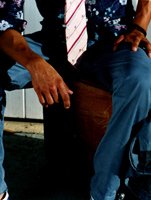Trovata
Trovata means “found” in Italian. And the corduroy blazers, khaki tailored pants, striped polo shirts and other garments made under the Trovata label look as if they could have been found in the closet of a surfer from the 1960s with a cool sense of style.
Based in Newport Beach, Calif., Trovata was formed by Jeff Halmos, Josia Lamberto-Egan, Sam Shipley and John Whitledge. The four, who met as teen-agers, originally designed surfwear cut with a fashion edge. Their signature pieces are blazers featuring velvet-trimmed pockets and T-shirts printed with irreverent slogans and pictures. (One shirt with an image of Cape Cod bears the caption “right side of the tracks.”) As one fan commented on a Web site, “Trovata makes really dope shirts and they’re nice guys to boot.”
The four launched a test line while they were college seniors in 2002. Wearing suits and ties, they did the rounds at trade shows in New York and Las Vegas. For their first full collection in Fall 2003, they had just 20 international accounts, albeit influential ones such as Barneys New York. Their Spring 2005 line will be carried by 200 retailers, including London’s Harvey Nichols and Bloomingdale’s. The new women’s line, debuting in Spring 2005 with 35 pieces, 10 fewer than the men’s collection, will be sold worldwide in about 50 stores, including Ron Herman.
The quartet’s efforts have been acknowledged by the Ecco Domani Fashion Foundation, which awarded Trovata a $25,000 grant to produce its first runway show during New York Fashion Week in February. Though Trovata won for its menswear, it will present Fall 2005 clothes for men and women. “It’d be interesting to bring that California vibe to New York,” said Halmos, who oversees sales and marketing.
That isn’t a bad showing for four chaps in their mid- 20s with almost no fashion experience (Whitley completed a summer design internship at Abercrombie & Fitch). Shipley, who codesigns with Lamberto-Egan and Whitledge and serves as art director, said they learned to concentrate on well-fitting and wearable clothes rather than to design for design’s sake. Gone are suede shorts. Popular are corduroy pants with antique nickel glass shanks and pockets that fit a passport. Lamberto-Egan, who is production director, said they will use “more grown-up” materials such as wool and tweed for Fall 2005.
“By no means are we reinventing the wheel,” Whitledge, the creative director, wrote in an e-mail from Itacare, Brazil. He said the Spring 2005 line was inspired by his Brazilian girlfriend and trips to Itacare, a beach town south of Salvador. “We are just taking classic clothes and adding our details, colors and fabrics to reflect our lifestyle.”
The Trovata lifestyle is embodied in a silk-screen drawing of a bikini-clad woman on a pocket flap, avocado green and other colors reminiscent of a 1970s kitchen, and prep school–era fabrics such as seersucker. All alumni of prep schools, the designers tweak the paradigm upheld by the East Coast’s old-money establishment. “That’s what we poke fun at,” Halmos said. “But respect,” Shipley quickly added.
A quirky story accompanies each collection, introducing fictitious characters such as Theodore Arbuckle III. Wholesale prices range from $21 for T-shirts to $75 for pants and $150 for blazers. The team deliberately excluded denim. Halmos declined to provide revenue figures.
Trovata’s creativity and attention to detail help it stand out, said Amy Blessing, co-owner of Apartment Number 9 in Los Angeles, who began stocking Trovata in early 2004. The combination of moderate prices, good fit and appealing colors resonates with consumers, she explained. She said Trovata’s pants, corduroy blazers and printed T-shirts are bestsellers. And she supports Trovata’s decision to steer clear of denim. “The last thing I need is one of my designers to get on the denim bandwagon,” she said. —Khanh T.L. Tran
























